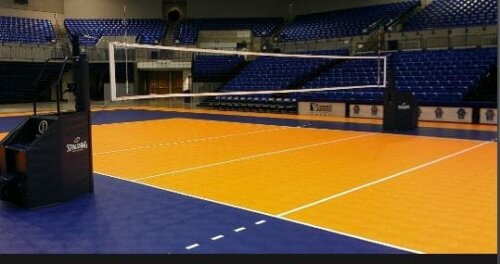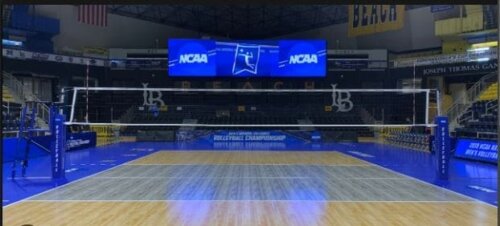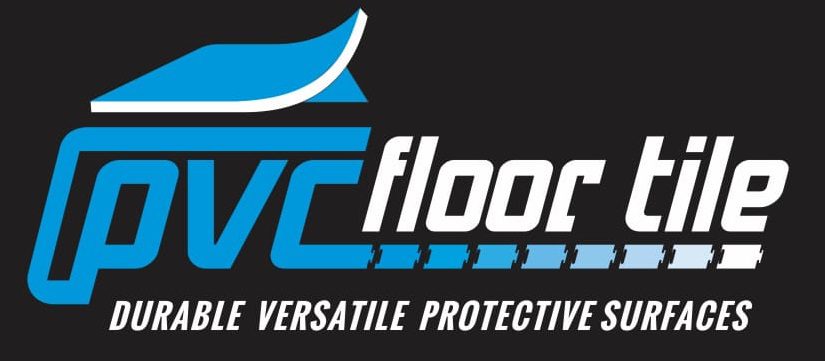
When it comes to setting up a volleyball court, choosing the right flooring is of paramount importance. The right flooring not only provides a safe and comfortable surface for players but also enhances the overall playing experience.
In this article, we will explore up to 10 popular types of volleyball court flooring options, including our own product, the Pvcocity Sports Tile. We will discuss each option’s top uses, along with the pros and cons to help you make an informed decision for your volleyball court needs.
Pvcocity Sports Tile:VolleyBall Court Flooring
Our very own Pvcocity Sports Tile is a cutting-edge flooring solution designed specifically for volleyball courts. Made from durable PVC material, this interlocking tile system offers numerous advantages. Its top surface provides excellent grip, minimizing the risk of slips and falls. The shock-absorbing properties ensure player safety, reducing the risk of impact injuries. Additionally, Pvcocity Sports Tile is easy to install and maintain, making it an ideal choice for both indoor and outdoor volleyball courts.
Top uses:
- Indoor volleyball courts in sports complexes, schools, and community centers.
- Outdoor volleyball courts in parks, recreational areas, and beach volleyball courts.
Pros:
- Exceptional grip and shock absorption for enhanced player safety.
- Easy installation and maintenance.
- Durable and long-lasting, ensuring a high return on investment.
- Can be customized with different colours and patterns.
- Suitable for both indoor and outdoor use.
- Versatile and can be used for various sports activities, including basketball and tennis.
Cons:
- May require professional installation for optimal results.
- Higher initial cost compared to some other options.
- Limited availability in certain regions.
- Not suitable for high-level professional competitions.
- Requires proper cleaning and maintenance to prevent debris buildup.
- May produce a slight odour during initial installation.

Maple Hardwood Flooring:
Maple hardwood flooring is a classic choice for many sports courts, including volleyball. Its smooth surface and natural wood aesthetics create an elegant and professional atmosphere. Maple offers excellent shock absorption and consistent ball bounce, making it a popular option for both professional and recreational volleyball courts.
Top uses:
- Indoor professional volleyball courts.
- Gymnasiums in schools and universities.
- Recreational centres and private sports facilities.
Pros:
Exceptional shock absorption for player safety.
Consistent ball bounce and surface performance.
Attractive appearance, enhancing the overall ambiance of the court.
Easy to clean and maintain.
Long-lasting and resistant to wear and tear.
Widely available and customizable with different finishes.
Cons:
- Expensive initial investment.
- Susceptible to scratches and dents.
- Requires regular refinishing to maintain performance.
- Sensitive to moisture and humidity, necessitating proper climate control.
- Not suitable for outdoor or beach volleyball courts.
- May require professional installation and periodic maintenance.
Synthetic Turf:
Synthetic turf has gained popularity in recent years as a versatile and low-maintenance option for volleyball courts. Made from artificial fibres, it provides a consistent playing surface with natural grass-like aesthetics. Synthetic turf offers excellent shock absorption and allows for consistent ball bounce, making it a suitable choice for recreational as well as professional volleyball courts.
Top uses:
- Outdoor recreational volleyball courts.
- Indoor volleyball courts with limited maintenance requirements.
- Multi-sport facilities looking for a versatile flooring solution.
Pros:
- Low-maintenance and resistant to wear and tear.
- Consistent playing surface with excellent shock absorption.
- No watering or mowing required, saving time and resources.
- Suitable for both indoor and outdoor use.
- Can be customized with different colours and logos.
- Provides additional cushioning and reduces the risk of impact injuries.
Cons:
- Initial cost may be higher compared to some other options.
- Limited temperature tolerance may become hot in extreme heat.
- Requires proper drainage for outdoor use.
- May have a slight odour during the initial installation.
- Not suitable for high-level professional competitions due to the difference in ball bounce.
- Requires regular brushing to maintain the turf’s upright position.

Polyurethane Flooring:
Polyurethane flooring is a popular choice for volleyball courts, thanks to its durability, easy maintenance, and consistent performance. This seamless and resilient surface provides excellent shock absorption, ensuring player safety during intense games. It is commonly used in indoor sports facilities and recreational centres.
Top uses:
- Indoor volleyball courts in schools, colleges, and universities.
- Professional indoor volleyball arenas.
- Community sports facilities and private clubs.
Pros:
- Excellent shock absorption, reducing the risk of injuries.
- Durable and resistant to wear and tear.
- Easy to clean and maintain.
- Provides a seamless and non-slip surface.
- Can be customized with different colours and logos.
- Highly resistant to water and chemical spills.
Cons:
- Higher initial cost compared to some other options.
- May require professional installation.
Limited availability in certain regions.
Rubber Flooring:
Top 8 Uses:
Indoor and outdoor volleyball courts, gymnasiums, recreational facilities, school sports halls, fitness centres, training areas, multipurpose venues, backyard courts.
Pros:
Provides excellent shock absorption and player comfort, slip-resistant and offers good traction, durable and long-lasting, easy to install and maintain, available in various colours and thicknesses, suitable for both indoor and outdoor use.
Cons:
Limited ball bounce compared to hardwood flooring, may have a slightly slower gameplay due to higher traction, can have a strong rubber odour initially, susceptible to fading and discoloration from UV exposure, less aesthetic appeal compared to other options, not suitable for professional leagues.
Interlocking Tiles:
Top 8 Uses:
Indoor and outdoor volleyball courts, sports facilities, community centres, school sports halls, multipurpose venues, backyard courts, training areas, recreational facilities.
Pros:
Easy to install and remove, modular design allows for customization and versatility, offers good shock absorption and player safety, durable and low maintenance, suitable for both indoor and outdoor use, available in different materials and thicknesses.
Cons:
Ball bounce may vary depending on the material and thickness, may shift or move if not properly secured, visible seams between tiles, not as aesthetically pleasing as other options, can be slippery when wet, may require occasional replacement of damaged tiles.
Vinyl Flooring:
Top 8 Uses:
School gyms, indoor volleyball courts, recreational facilities, training areas, multipurpose venues, community centres, fitness centres, backyard courts.
Pros:
Provides good ball bounce and player traction, durable and low maintenance, easy to clean and sanitize, offers a wide range of colours and patterns, suitable for both indoor and outdoor use, cost-effective option.
Cons:
Can be slippery if not properly maintained, sensitive to temperature changes, prone to wear and tear over time, may require periodic refinishing, can get damaged by heavy equipment or sharp objects, not suitable for professional leagues.
Concrete:
Top 8 Uses:
Outdoor volleyball courts, beach volleyball courts, backyard courts, recreational areas, parks, community centres, sports facilities, multipurpose venues.
Pros:
Cost-effective option, extremely durable and long-lasting, requires minimal maintenance, withstands harsh weather conditions, offers good ball bounce and player traction, suitable for various outdoor sports.
Cons:
Hard surface with minimal shock absorption, may cause discomfort or injury to players, limited customization options, can be slippery when wet, not suitable for indoor use, may require periodic resurfacing for optimal performance.

